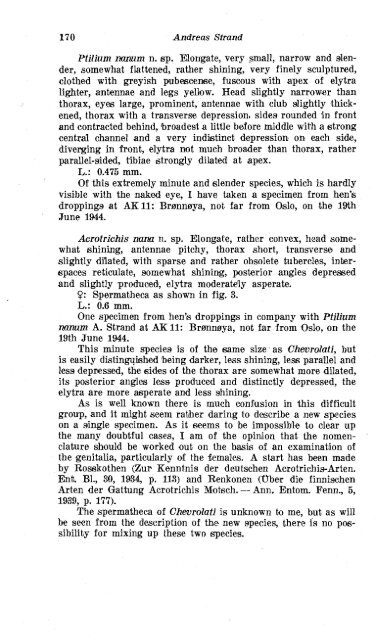3 - Norsk entomologisk forening
3 - Norsk entomologisk forening
3 - Norsk entomologisk forening
Create successful ePaper yourself
Turn your PDF publications into a flip-book with our unique Google optimized e-Paper software.
170 Andreas Strand<br />
Ptilium m um n. sp. Elongate, very small, narrow and slen-<br />
der, somewhat flattened, rather shining, very finely sculptured,<br />
clothed with greyish pubescense, fuscous with apex of elytra<br />
lighter, antennae and legs yellow. Head slightly narrower than<br />
thorax, eyw large, prominent, antennae with club slightly thick-<br />
ened, thorax with a transverse depression, sides rounded in front<br />
and contracted behind, broadest a little before middle with a strong<br />
central channel and a very indistinct depression on each side,<br />
diverging in front, elytra not much broader than thorax, rather<br />
parallel-sided, tibiae strongly dilated at apex.<br />
L.: 0.475 nun.<br />
Of this extremely minute and slender species, which is hardly<br />
visible with the naked eye, I have taken a specimen from hen's<br />
droppings at AK11: Brmnnrya, not. far from Oslo, on the 19th<br />
June 1944.<br />
Acrotrichis nana n. sp. Elongate, rather convex, head some-<br />
what shining, antennae pitchy, thorax sh'ort, transverse an'd<br />
slightly dilated, with sparse and rather obsolete tubercles, intier-<br />
spaces reticulate, somewhat shining, posterior angles depressed<br />
and slightly produced, elytra moderately asperate.<br />
9: Spermatheca as shown in fig. 3.<br />
L.: 0.6 mm.<br />
One specimen from hen's droppings in company with Ptilium<br />
nanum A. Strand at AK11: Brnrnn~ya, not far from Oslo, on the<br />
19th June 1944.<br />
This minute species is of the same size as Chevrolati, but<br />
is easily distingqished being darker, less shining, less para'llel and<br />
less depressed, the sides of the thorax are somewhat more dilated,<br />
its posterior angles less produced and distinctly depressed, the<br />
elytra are more asperate and less shining.<br />
As is well known there is much confusion in this difficult<br />
group, and it might seem rather daring to describe a new species<br />
on a single specimen. As it seems to be impossible to clear up<br />
the many doubtful cases, I am of the opinion that the nomen-<br />
clature should be worked out on the basis of an examination of<br />
the genitalia, particularly of the females. A start has been made<br />
by Rosskothen (Zur Kenntnis der deutschen Acrotrichis-Arten.<br />
En8. Bl., 30, 1934, p. 113) and Renkonen (Uber die finnischen<br />
Arten der Gattung Acrotrichis Motrsch. -- Ann. Entom. Fenn., 5,<br />
1939, p. 177).<br />
The spermatheca of Chevrolati is unknown to me, but as will<br />
be seen from the description of the new species, there is no pos-<br />
sibilitly for mixing up these two species.

















